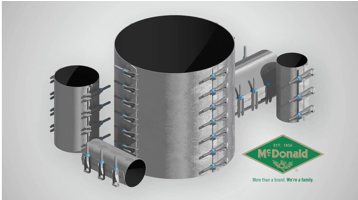Making water work is no easy task. In fact, it can be a thankless job for those who provide the convenience of water where we need it, when we need it. At A.Y. McDonald, we give respect to those who do whatever it takes to make water work, 24/7 – 365 days a year. Whether this means sitting in the bottom of a trench, working in the midst of a thunderstorm, or being on call on Thanskgiving morning – someone’s got to do it. One of the ways in which this is done is by fixing water main breaks immediately after they’re spotted.
There is an estimated 1,180,000 miles of water main pipes located in the United States. Recognized as a main line in a water supply system, this major part of the water service lateral aids in the movement of water from the regional source of supply (usually reservoirs or pumping stations) to consumers. With so much influence in making water work, what happens when a water main breaks?
Just like any other appliance or device, maintenance has to be applied to a water main every now and then – especially when ground shifting, old age, corrosion, and/or climate change is present. While located a number of feet underground, there is no way for the pipes to tell us of a water main break or leak so one simply has to pay attention to the signs. This can be as subtle as a soggy patch of grass in between the sidewalk and curb to as obvious as a sinkhole in the ground or a measurable pressure drop in the system.
After the water main break has been spotted, it is often reported to the city. From there, the utility has its own list of procedures that must be followed in the event of replacement or repair. Throughout the process, they will most likely perform the following six steps in order to rectify the situation:
- Step 1: Locate the Water Main Break
Although the ground shows signs of a water main break, it is not uncommon for a water main break to travel ten to twenty feet from the source of the leak. In order to properly pinpoint the affected portion of pipe, the utility may use an acoustic leak detection device that helps them actually hear and decipher the difference between healthy and unhealthy underground pipes.
- Step 2: Shut Off Water to the Broken Section
Any time there is a break in a water line, this leaves the pipes vulnerable to debris from the surrounding area seeping into the water inside the pipe. Therefore, in the event of a water main break, the utility will shut off the water to the broken section and a ‘boil water advisory’ is often imposed to the affected area until after the job is complete.
- Step 3: Call in Other Utilities to Mark Where Pipes Are
In order to provide the least amount of inconvenience possible, other utilities may be required to mark where pipes are located so that the water utility can dig safely. This minimizes any further damage to pipes and the time spent underground making repairs.
- Step 4: Dig to the Broken Pipe to Patch or Replace the Water Main
Next, the water utility uses bulldozers, drills, and other equipment to reach the broken pipe itself. As soon as this is achieved, they apply a metal repair clamp to the broken area, which creates the appropriate amount of pressure to stop any leaks. Depending on the situation, they might replace the entire portion of piping.
- Step 5: Flush the Water Main
After the water main has been replaced or repaired, it is finally time to reconnect it into the water system. This is best performed by flushing the water main, as it ensures the cleanest reconnection possible.
- Step 6: Restore the Site
With the water supply pipes located underground, the digging probably caused some havoc to the area. After completing the water main replacement or repair, the utility will replace the soil and restore the site as best as possible. This could mean repairing a road or sidewalk as well. When it’s all said and done, it should appear as if nothing even happened on the site.
As the pipes that carry potable water to homes and businesses, water mains are a huge contributing factor to making water work for your community – and so is fixing them. With 240,000 water main breaks that occur annually in the U.S., we salute the heroes that fix these problems quickly and get us back to normal, bringing us water where we need it, when we need it, and making water work again.


